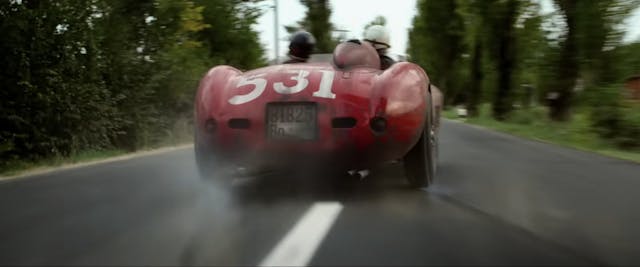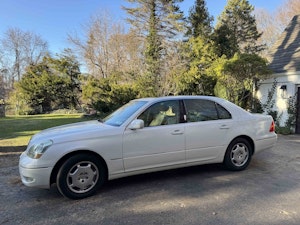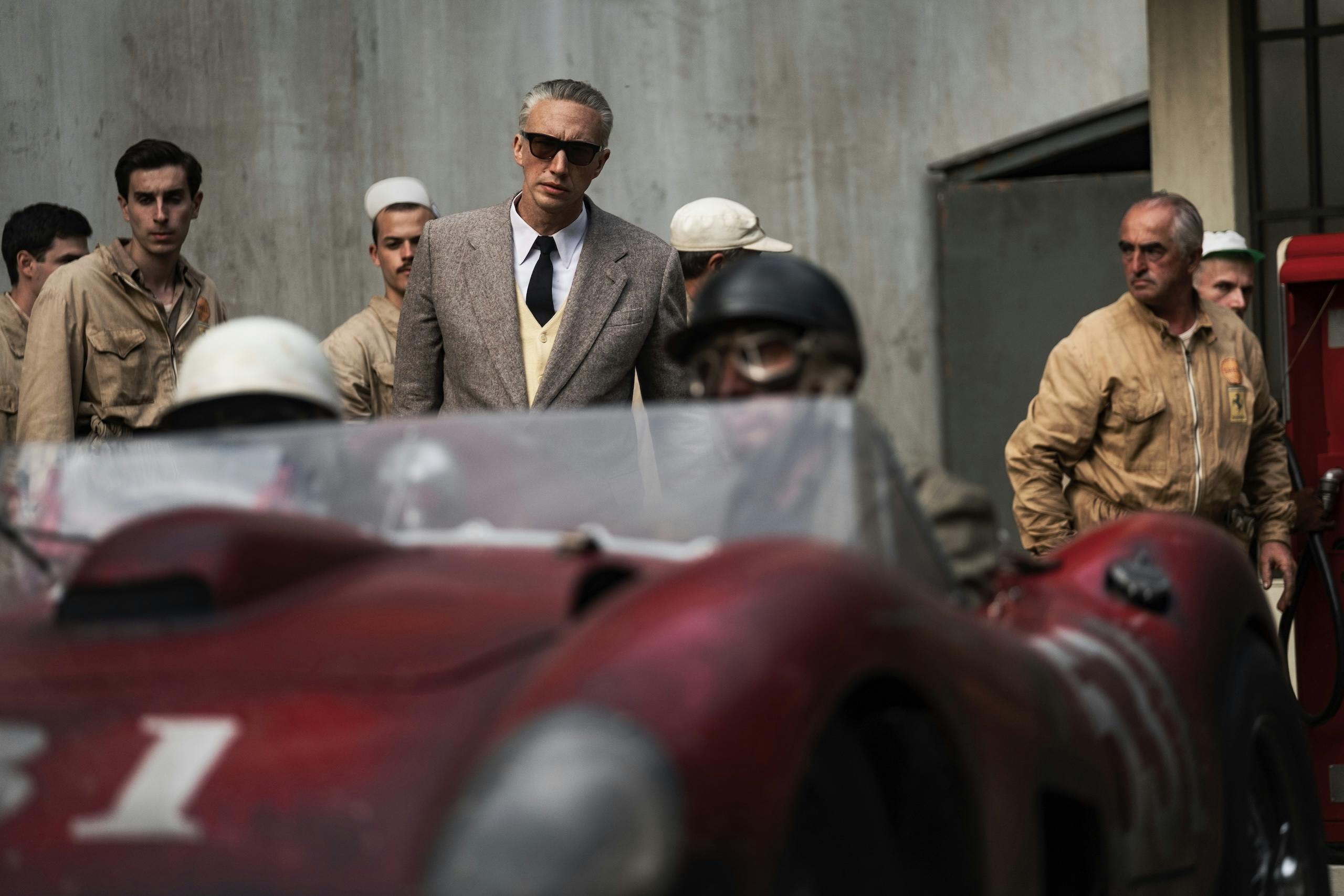Media | Articles
What the glorious cars from Michael Mann’s Ferrari are worth
With Michael Mann’s Ferrari movie hitting theaters in a few days, we’ve been watching the trailer and doing what car people do—car spotting. Set during just a few tumultuous months during 1957, it explores both the personal struggles of Enzo Ferrari and the critical economic challenges facing the automaker at that time. The backdrop, meanwhile, is a golden age of motorsports that produced the most desirable and valuable cars in history.
After combing through the trailer and production information, as well as looking through the actual events, we’ve picked out some of the main cars. And, based on recent private transactions and past auction results brought forward using our Ferrari Market Index, we’ve calculated their values.
It’s also important to note that no eight-figure Ferraris were harmed in the making of this film. Most of the race cars seen on screen are replicas.
Lancia-Ferrari D50: $2,000,000

Although most of Lancia’s great racing moments were with sports or rally cars, the Italian firm had a brief but memorable go at Formula One racing in 1954-55. Designed by Vittorio Jano, the D50 was both clever and beautiful. A dual-overhead cam V-8 served as a stressed member of the tubular chassis for added rigidity, and a five-speed transaxle in the rear improved balance. The most unusual and recognizable feature were the fuel and oil tanks, mounted in pods nestled inside the wheelbase on either side of the driver.
The D50 debuted in late 1954 and started the 1955 pre-season with two victories, but the death of Lancia’s star driver Alberto Ascari when testing a Ferrari sports car, as well as mounting money troubles, led Lancia to offload its whole F1 project to Ferrari. The latter company, along with driver Juan Manuel Fangio, took modified versions of the D50 (now wearing a prancing horse) to the 1956 World Championship.
Of six cars completed in period, only two legitimate D50s are said to have survived. Both are in long-term collections/museums, but a recreation done to exacting standards from original plans and advertised with an FIA Historic Technical Passport sold nine years ago for €812,000 ($1,117,555 at the time).
Maserati 250F: $5,000,000

While the Lancia-Ferrari D50 was an unconventional Grand Prix car, the Maserati 250F was mostly standard practice for 1950s F1 machinery. The inline-six engine, simple tubular chassis, suspension (wishbones/coil springs in front, DeDion axle in rear), and overstuffed-cigar-shaped styling were common sights on many F1 cars during that decade. The Maserati, though, was well-executed, powered by a gem of an engine, and driven by top talent. It was also a prolific car with over two dozen built, and privateers used 250Fs alongside the factory team. 250Fs appeared on the grid from 1954 to 1960, and while they weren’t always at the front, that’s still an impressively long run in a sport known for being at the cutting edge of car design.
The 250F won its first race in 1954, and amassed a total of eight championship race wins, including Fangio’s epic drive at the Nürburgring in 1957. Sir Stirling Moss called it “probably the nicest, most user-friendly F1 car” and “without doubt the finest handling front-engined F1 car I think built by anybody.”
Naturally, it’s not the kind of car that pops up for sale often, but an ex-Stirling Moss, Italian GP-winning car sold for $4.62M back in 2014.
Ferrari 250 GT TdF: $6,500,000

The Tour de France Automobile was a long-distance sports car race held on roads and race circuits throughout, you guessed it, France. It ran annually from 1951 to 1986, and for four years straight from 1956-59 the 3600-mile event was won by Ferrari’s dual-purpose road/race model – the 250 GT. Alfonso de Portago, the Spanish nobleman/race driver depicted in the film, delivered the first of these Tour de France wins for Ferrari. The company didn’t originally call this car the “Tour de France” or “TdF,” but it’s easy to see how the name stuck given the car’s dominance.
Ferrari built between 70 and 80 original 250 GT TdFs. Their prices can range widely depending on history, originality and bodywork, even down to how many vents are behind the side windows. But they do come to market regularly enough to calculate a reliable Price Guide value. They range from $5.7M for a #4 (Fair) condition car to $7.8 for a concours-ready #1 condition example, but exceptional ones have sold for more than that. That ex-Portago Tour de France winner, for example, sold for $13.2M in 2015.
Ferrari 500 TRC: $8,000,000

Widely considered to be the most beautiful of Ferrari’s Testa Rossa designs, 500 TRC is also notable for its engine. Or its engine’s missing cylinders, depending on how you look at it—what’s under that sculpted hood isn’t a wailing V-12 but a barking 2.0-liter four-cylinder.
Four-banger Ferraris like the 500 Mondial, 750/860 Monza and 500 TRC either raced in smaller displacement sports car categories or leveraged reliability to achieve overall wins. And while they lack the piston count of the 12-cylinder cars, they don’t lack one bit of the style. They took their fair share of checkered flags, too. Ferrari built just 19 500 TRCs, and sold most of them to customers. When it was a new, internationally-competitive race car, Ferrari sold 500 TRCs for about $11,000 (about $118,000 today). The last one seen at auction was in 2022, and it brought $7.815M.
335 Sport: $36,000,000

Because the 335 S and 315 S were the focus of Ferrari’s attack on the 1957 Mille Miglia, the main subject of the film, this car will likely see a large share of screen time. These Scaglietti-bodied V-12 sports cars were themselves evolutions of the 290 MM, which had given Ferrari victory in the 1956 running of the 1000-mile Italian race. The 315 S was the 3.8-liter version, with about 355 hp. The 335 S was the 4.0-liter version, with 390 hp.
For the 1957 World Sportscar Championship, both had stiff competition from the new 400-hp Maserati 450S as well as the Aston Martin DBR1 and Jaguar D-Type. For the Mille Miglia, however, early retirements among the Maseratis left Enzo Ferrari in a much more comfortable position. By the final hours of the race, his cars filled most of the top ten spots. Then, just miles from the finish, the left front tire blew on de Portago’s 335 S. He crashed, killing himself along with his navigator Edmund Nelson and nine spectators. Ferrari won the Mille Miglia and the 1957 championship, but it was a tough year for Il Commendatore. As a result of de Portago’s accident, the Mille Miglia would be no more, and the Italian authorities charged both Enzo and the tire manufacturer with manslaughter. The charges were eventually dismissed.
Another 335 S sold at auction in 2016 for €32.075M ($35.7M). At the time, it was the most expensive auction car ever sold in Europe.
315 Sport: $36,000,000

Ahead of the carnage following de Portago’s accident in the 335 S, the less powerful 315 S took the first two spots, with Piero Taruffi (played by Patrick Dempsey) followed by Wolfgang von Trips. It’s Taruffi’s car, number 535 and the winner of the last ever Mille Miglia, that appears on the poster for the film.
Ferrari built just three of these cars in period, and while there are records of 315s selling in the 1990s, that was a vastly different market than today’s. Given the lack of recent data, the closest comparable sale would be the $35.7M 335 S mentioned above.

***
Marketplace
Buy and sell classics with confidence
Check out the Hagerty Media homepage so you don’t miss a single story, or better yet, bookmark it. To get our best stories delivered right to your inbox, subscribe to our newsletters.














Take four zeros off those prices and I would be in the game. But I’m not going to lose any sleep over that. My trusty old MG TC and my Guzzi singles fill the sport motoring niche in my life without the security risksb associated with high end vehicles.
It would be nice if the actual chassis numbers of the cars were published. I’m curious as to whether I’ve personally driven one of them. The chassis number would tell.
I wonder if you tallied up the price of all the cars shown racing in the movie ‘Le Mans ‘ what that total would be. Make a hell of a reunion event too.
The 250 Tdf for me.
I think the author should give a spoiler alert.
ps if you really want to see a great movie about about racing watch the documentary ‘ Grand Prix- The Killer Years ‘ ( if you can find it ). An un -hollywood – ed true version of those years. But, spoiler alert Bill ! don’t get attached to all those real drivers for many it was their last.